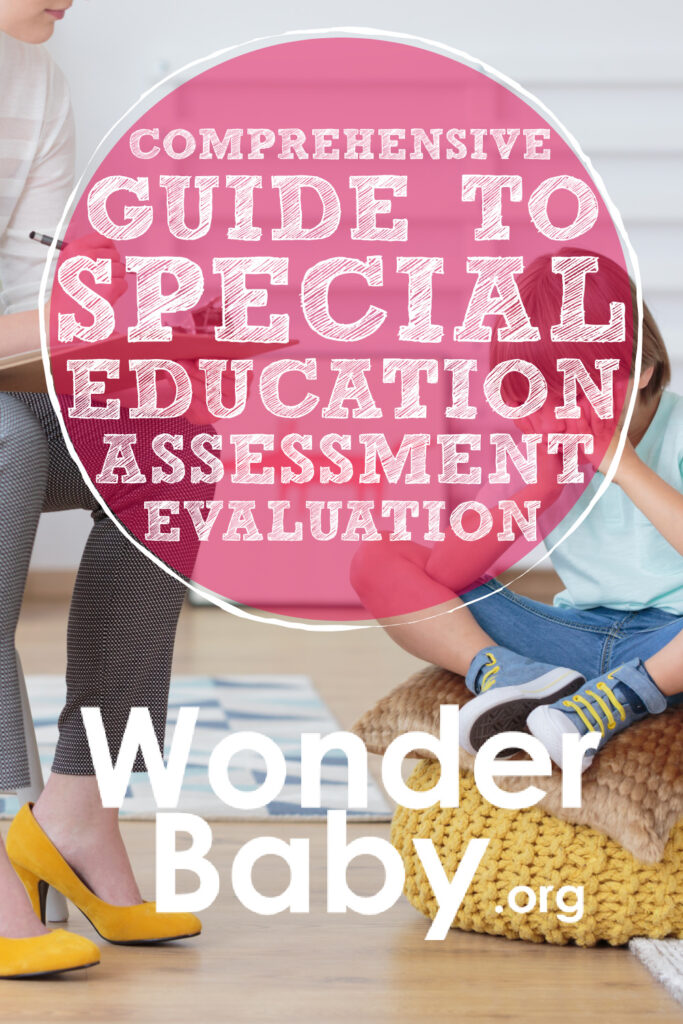A Comprehensive Guide to Special Education Assessment and Evaluation

- A special education assessment is a process used to determine whether a child qualifies for special education and related services because of a learning disability.
- Every school district will conduct the evaluation differently; however, all must comply with the requirements for special education assessments set out in the federal law known as IDEA.
- A special education assessment is not a single test to evaluate a child’s academic achievement or intellectual ability.
- The assessment is a process of gathering information about a child from a variety of sources using different methods, tools, and evaluation materials to determine what interventions they may need.
Maybe you’ve noticed that your child is struggling with reading or writing. Perhaps you’re concerned about their behavior or how they’re engaging with other children. Or your child’s teacher has come to you with some concerns about their language and speech development, or they’ve noticed they’re not keeping up with their classmates.
When these kinds of concerns come up either for you or from your child’s teachers, it may be time for a special education assessment. An assessment can give you insight into your child’s learning and abilities. It’s also the process that can determine if your child has disability-related educational needs.
If they do, your child may qualify for special education and related services. The special education assessment is the first step in the process of making sure your child gets the support they need to access their education and achieve in school to the best of their ability.
Read our comprehensive guide to special education assessment and evaluation to learn more about this important process.
What is a Special Education Assessment?

A special education assessment11. Understanding assessment in special education. AASEP. http://aasep.org/fileadmin/user_upload/Protected_Directory/BCSE_Course_Files/Course_3/UNDERSTANDING_ASSESSMENT.pdf, or SPED assessment, is the process of gathering information about a child through tests, interviews, and observations with different professionals to determine two things:
- The child’s strengths and educational needs
- Whether the child is eligible for special education services
Different terms for special education assessment22. Lee, A.. Different terms you may hear for evaluations. Understood. https://www.understood.org/en/articles/different-terms-you-may-hear-for-evaluations may be used depending on your school district such as:
- Special education evaluation
- School evaluation
- IEP (individualized education program) evaluation
- Comprehensive or multidisciplinary evaluation
How Does a Special Education Assessment Work?
The conduct of special education assessments is governed by IDEA, the Individuals with Disabilities Education Act.
This important federal law guarantees the rights of children with disabilities to a free and appropriate public education in the least restrictive environment. It’s the civil rights legislation that protects students with disabilities and ensures their right to education.
Section 1414 of the act33. Section 1414. Individuals with Disabilities Education Act. 2019. https://sites.ed.gov/idea/statute-chapter-33/subchapter-ii/1414 specifically details how the special education evaluation process should proceed in several steps.
Step 1: Referral

A parent, guardian, teacher, special education teacher, or school can refer a child for an initial evaluation44. Evaluating Children to Determine Eligibility for Special Education Services and Reevaluation Requirements. Learning Disabilities Association of America. https://ldaamerica.org/info/evaluating-children-who-have-been-referred-to-determine-eligibility-for-special-education-services-and-requirements-for-reevaluation to determine whether a child has a disability. This step is usually taken when a parent, guardian, or teacher recognizes that a child needs additional support and suspects that there may be a need for extra educational assistance.
Once the referral is made for the child’s initial evaluation, the parents or guardians must provide their consent. The assessment must then take place within 60 days of obtaining parental consent.
Step 2: Evaluation

Under IDEA Section 1414(b)(2)(A), the school will then start the individual initial evaluation by using, “a variety of assessment tools and strategies to gather relevant functional, developmental, and academic information, including information provided by the parent.”
The evaluation cannot be based on just a single test or assessment tool, and must make use of existing evaluation data and different technically sound processes that assess the child’s cognitive, behavioral, physical, and developmental strengths and needs.
Importantly, the tests and instruments used must also:
- Be racially and culturally non-discriminatory.
- Be provided in the child’s native language.
- Be administered by trained and knowledgeable personnel.
- Assess the child in all areas of suspected disability.
In practice, this means the school may do things in addition to administering tests to the child, like gathering previous test scores, examining school records, giving questionnaires to parents, caregivers, and teachers, and observing the child in the classroom to complete the special education evaluation55. The Understood Team. What is an evaluation for special education?. Understood. https://www.understood.org/en/articles/understanding-evaluations.
In addition, parents and caregivers can expect their child to be evaluated by other professionals such as a school psychologist, speech-language pathologist, or other specialist who is knowledgeable about the specific nature of the child’s suspected disability.
All of this information will then be taken together to determine whether a child has a specific learning disability or developmental delay that makes them eligible for special education services.
Step 3: Individualized Educational Programming

Once the child’s initial full and individual evaluation process is complete and it is decided that the child requires special education, a meeting is held to develop and discuss their IEP, or individualized education program.
The IEP team, which includes the child’s parents or caregivers, teachers, and other specialists, will work together to put an appropriate educational program in place that meets the child’s specific needs.
The IEP is a document that details the child’s educational placement and any additional services they require to access their education. The IEP process66. Sec. 300.320 Definition of individualized education program. Individuals with Disabilities Education Act. 2017. https://sites.ed.gov/idea/regs/b/d/300.320 is also outlined in detail in IDEA.
Step 4: Reevaluation
Once the child starts to receive special education services and their IEP is actioned, a reevaluation must take place every year under the law.
This yearly assessment process measures the child’s progress and modifies their IEP as necessary so they can continue to benefit from the special education process.
Types of Special Education Assessments

IDEA requires schools to use different tools when assessing students for learning disabilities and eligibility for special education. Schools may not simply use one test and then declare that a child does or does not have a learning disability that requires educational support.
An evaluation should consist of a mix of standardized educational tests, curriculum-based assessment, observation, and interviews and questionnaires with the child and their caregivers and teachers to take a closer look at a child’s behavior.
Assessment According to Disability Category
The type of assessments a child will participate in to determine special education eligibility77. Eligibility: Determining Whether a Child is Eligible for Special Education Services. Learning Disabilities Association of America. https://ldaamerica.org/info/eligibility-determining-whether-a-child-is-eligible-for-special-education-services will depend on what kind of learning disability caregivers and teachers suspect might be present.
There are 13 categories of disability88. Lee, A.. The 13 disability categories under IDEA. Understood. https://www.understood.org/en/articles/conditions-covered-under-idea included under IDEA:
- Specific learning disorder, like dyslexia, dyscalculia, or dysgraphia
- Other health impairment, which covers conditions that limit strength, alertness or energy, like ADHD
- Autism spectrum disorder
- Emotional disturbance, such as depression, obsessive-compulsive disorder, or anxiety
- Speech or language impairment
- Visual impairment and blindness
- Deafness
- Hearing impairment
- Deaf-blindness
- Orthopedic impairment
- Intellectual disability
- Traumatic brain injury
- Multiple disabilities
Special education assessments for each of these categories will examine different criteria to determine the child’s eligibility for special education and related services.
Response to Intervention (RTI)

One tool a school may use early in the assessment process is response to intervention or RTI99. What is RTI? RTI Action Network. https://www.rtinetwork.org/learn/what/whatisrti. RTI is a process in which a teacher will assess an entire class and then break the class into smaller groups depending on skill levels and abilities.
Instruction is then tailored to those groups and the response of students to that instruction is observed. Information gathered about a child from RTI can be used as part of their initial assessment.
Common Tests Used for Special Education Assessment
Different standardized tests and instruments may be used to examine a child’s cognitive abilities, motor abilities, language fundamentals, physical disabilities, or psycho-social development.
Each school system may use a different combination of tools in completing a comprehensive assessment, but some of the more common tests you may come across are listed below:
| Intelligence tests: Wechsler Intelligence Scale for Children | An intelligence test used for children from ages 6 to 16 years. Provides an overall measure of general cognitive ability. Composed of several tests including verbal comprehension, perceptual reasoning, working memory, and information processing speed.Commonly used to evaluate ADHD and dyslexia. |
| Achievement tests: Kaufman Test of Educational Achievement, Woodcock-Johnson IV Tests of Achievement | Tests commonly used to measure reading, writing, and math skills to diagnose a learning disability. |
| Visual-motor tests: Bender Visual-Motor Gestalt Test | Used for children age 4 and up to assess visual-motor integration. A test where the child is asked to look at line drawing and then redraw what they saw from memory. |
| Language skills test: Clinical Evaluation of Language Fundamentals | A test used to diagnose language disorders in students age 5 to 21. A battery of tests are used to identify language strength and weakness. |
Assessment Tools and Techniques

Standardized tests for cognitive ability and academic achievement should only be one part of a comprehensive assessment.
Your child may also be asked to engage with computer-based, interactive tools, like a Quantified Behavioral Test, or Qb Test, which measures attentiveness and impulsivity common to ADHD.
In addition to these psycho-educational tests, the assessment may also consist of:
- Interviews in person or via questionnaire with the child, parents and caregivers, and teachers.
- Classroom observation to watch how the child learns and interacts in class with peers.
- Psychological evaluation to find out about a child’s feelings, emotions, social skills, and social anxiety.
- Other evaluations specific to the child’s needs, like occupational or physical therapy, or evaluation by a speech-language pathologist.
Parents’ and Caregivers’ Rights

Under IDEA, parents and caregivers may request a special education evaluation at any time. If the school agrees to the evaluation, it must be carried out within 60 days of obtaining informed consent.
An evaluation cannot be carried out without the written consent of the parent or guardian, and they have the right to withdraw consent at any time.
In addition, parents and caregivers must be informed of the evaluation findings in writing. If parents disagree with the school’s decision to refuse an evaluation or with the results of the evaluation, parents have a right to due process under IDEA1515. Subpart E — Procedural Safeguards Due Process Procedures for Parents and Children. Individuals with Disabilities Education Act. 2017. https://sites.ed.gov/idea/regs/b/e to appeal those decisions.
Finally, if a parent or caregiver disagrees with the results of the school’s evaluation, they have a right to an independent educational evaluation or IEE1616. SEC. 300.502 Independent Educational Evaluation. Individuals with Disabilities Education Act. 2017. https://sites.ed.gov/idea/regs/b/e/300.502. This is an evaluation provided by a private qualified examiner at public expense, meaning that the child’s school must pay for it.
The school can file a due process complaint and request a hearing to determine whether it’s evaluation should stand or whether the child is entitled to an IEE. However, parents should know that there is recourse for them and their children if they disagree with the results found by the school.
All assessments of a child must also not discriminate based on race or culture and must be provided in the child’s preferred language.
References
- Understanding assessment in special education. AASEP. (n.d.). http://aasep.org/fileadmin/user_upload/Protected_Directory/BCSE_Course_Files/Course_3/UNDERSTANDING_ASSESSMENT.pdf
- Lee, A. (n.d.). Different terms you may hear for evaluations. Understood. https://www.understood.org/en/articles/different-terms-you-may-hear-for-evaluations
- Section 1414. Individuals with Disabilities Education Act. (2019, November 7). https://sites.ed.gov/idea/statute-chapter-33/subchapter-ii/1414
- Evaluating Children to Determine Eligibility for Special Education Services and Reevaluation Requirements. Learning Disabilities Association of America. (n.d.). https://ldaamerica.org/info/evaluating-children-who-have-been-referred-to-determine-eligibility-for-special-education-services-and-requirements-for-reevaluation
- The Understood Team. (n.d.). What is an evaluation for special education? Understood. https://www.understood.org/en/articles/understanding-evaluations
- Sec. 300.320 Definition of individualized education program. Individuals with Disabilities Education Act. (2017, July 12). https://sites.ed.gov/idea/regs/b/d/300.320
- Eligibility: Determining Whether a Child is Eligible for Special Education Services. Learning Disabilities Association of America. (n.d.). https://ldaamerica.org/info/eligibility-determining-whether-a-child-is-eligible-for-special-education-services
- Lee, A. (n.d.). The 13 disability categories under IDEA. Understood. https://www.understood.org/en/articles/conditions-covered-under-idea
- What is RTI? RTI Action Network. (n.d.). https://www.rtinetwork.org/learn/what/whatisrti
- Gomez, R., Vance, A., & Watson, S. D. (2016). Structure of the Wechsler Intelligence Scale for Children – Fourth Edition in a Group of Children with ADHD. Frontiers in Psychology, 7, 737. https://doi.org/10.3389/fpsyg.2016.00737
- Frame, L. B., Vidrine, S. M., & Hinojosa, R. (2016, December). Test Review: Kaufman, A. S., & Kaufman, N. L. (2014), “Kaufman Test of Educational Achievement, Third Edition.” Bloomington, MN: NCS Pearson. Journal of Psychoeducational Assessment. https://eric.ed.gov/?id=EJ1119370
- Woodcock-Johnson IV Tests of Achievement. Texas Education Agency. (n.d.). https://www.txautism.net/evaluations/woodcock-johnson-iv-tests-of-achievement#:~:text=Overview-,The%20Woodcock%2DJohnson%20IV%20Tests%20of%20Achievement%20(WJ%20IV%20ACH,ages%202%2D90%2B%20years.
- APA Dictionary of Psychology. American Psychological Association. (n.d.). https://dictionary.apa.org/bender-visual-motor-gestalt-test
- Clinical Evaluation of Language Fundamentals – Fifth Edition. Texas Education Agency. (n.d.). https://www.txautism.net/evaluations/clinical-evaluation-of-language-fundamentals-fifth-edition
- Subpart E — Procedural Safeguards Due Process Procedures for Parents and Children. Individuals with Disabilities Education Act. (2017, May 2). https://sites.ed.gov/idea/regs/b/e
- SEC. 300.502 Independent Educational Evaluation. Individuals with Disabilities Education Act. (2017, May 2). https://sites.ed.gov/idea/regs/b/e/300.502

Related Posts

Eye Conditions and Syndromes, Visual Impairment
Neuralink Announces Plans to Restore Sight to the Blind with Brain Chip
Elon Musk’s company Neuralink has announced plans to begin human trials of its new “Blindsight” brain chip by the end of 2025.

IEPs
What Should I Bring to My Child’s First IEP Meeting?
Prepare for your child's first IEP meeting with confidence! Discover exactly what documents to bring, including educational records, medical info, and questions to ask.

Special Needs
5 Spring Cleaning Tips for Families of Children with Disabilities
Spring cleaning is an opportunity to create a more accessible, organized, and supportive space for your child with disabilities. Declutter, deep clean, and refresh!